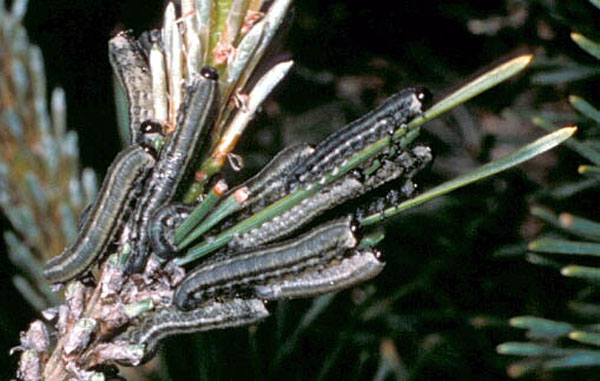Issue 2, May 6, 2013
European Pine Sawfly
European pine sawfly will have hatched in southern and central Illinois. They are likely to hatch in northern Illinois in about a week. The larvae appear similar to green caterpillars with dark green stripes and large black heads, growing to about one inch long. They are not true caterpillars; they have more than five pairs of prolegs and develop into wasp-like adults. The larvae feed in groups near the tips of branches and lie along the needles. When disturbed, they raise their heads and abdomens in unison which serves to scare predatory birds. They feed primarily on Scotch and mugo pines.
The larvae feed on the outer portions of the needles, leaving a brown core that curls and falls off of the branch. Although they strip all of the foliage off of branches, the branches are unlikely to die. The reason is that the larvae are feeding on the second and third year needles. They drop to the ground to pupate at about the same time that new needles are emerging from the developed candles. These first year needles carry on photosynthesis and food production for the branch, keeping it healthy. With only one generation per year, those needles will not be fed upon until the following spring. However, damaged branches will be bare except for a puff of first year needles at the tip, making the tree less aesthetically pleasing.

The larvae drop to the ground and burrow into the duff. They form oblong, tan cocoons in which they pupate. They emerge as one-half inch, black, wasp-like adults. After mating, the female sawfly uses her saw-like ovipositor to make longitudinal slices in the needles where she inserts her eggs. Usually about six eggs are laid per needle with several needles attacked per shoot. Attacked needles have a series of small, yellowish spots along them where the eggs have been laid. These eggs hatch into larvae in spring.
Control can frequently be achieved through hand-picking. Because the larvae feed in groups and usually only a few shoots per tree are attacked, it may be easiest to pick off the larvae or smash them on the foliage. Sprays of acephate (Orthene), acetamiprid (TriStar), azadirachtin (Azatin), carbaryl (Sevin), indoxacarb (Provaunt), or spinosad (Conserve) are effective. Because these are not caterpillars, Bacillus thurgiensis kurstaki does not provide effective control. (Phil Nixon)
Author:
Phil Nixon